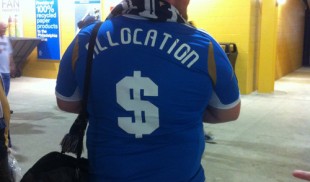Featured photo: Eli Pearlman-Storch
Allocation money jokes rarely get old in Philadelphia.
Among the things Philadelphia Union have traded for allocation money, according to Union fans, are human souls, and perhaps even the MLS Cup. There’s this gem: “The Union is proud to report that the Harrisburg City Islanders have been traded to Sporting KC for allocation money.” Then you have the Scrooge McDuck jokes and images.
The jokes have permeated like black humor among trauma survivors, hardly masking bitterness over former Union manager Peter Nowak’s unpopular trades of popular veterans Sebastien Le Toux and Danny Califf, largely for allocation money.
“I never thought I could hate two words as much I hate the combination of ‘allocation’ and ‘money,'” one fan commented.
Observers cannot gauge whether the Union received fair value in those deals because, unlike with European transfers, MLS keeps allocation money amounts secret to maintain negotiating leverage in player acquisitions. Combined with Nowak’s uncommunicative management style and perceived mistreatment of players, this fueled a fan revolt that culminated with Nowak’s firing this month.
On Wednesday, the MLS transfer window opens till July 27. The Union can finally close the loop on Nowak’s deals by using allocation money to acquire new players. At least one player has been on trial, and the signing of center back Bakary Soumare is expected to be announced today.
With that in mind, PSP talked to MLS and players union officials to go beyond the published league rules and explain how allocation money and the salary budget work. What we found is that allocation money is very useful but has its limits, the Union likely have a lot of it, and they can’t keep it forever.
The allocation money mystery
So what is allocation money?
“Very simply, allocation money is just money that a team can use that doesn’t count against the salary budget,” MLS Executive Vice President Todd Durbin said at the 2011 Supporters Summit last November.
Allocation money can be used to:
- Sign or resign a player;
- Exercise an option to buy a player’s rights;
- “Buy down” or decrease a player’s salary budget hit.
The league doles out allocation money for sale of Carlos Ruiz to Veracruz. Ten percent of a transfer fee goes to the player, MLS Players Union President Bob Foose told the Philly Soccer Page. Two-thirds of what remains goes to the club as allocation money, to a maximum of $650,000. The rest goes to the league.
Allocation money is a “rolling revenue stream” teams receive primarily during the offseason, MLS spokesman Will Kuhns explained. The MLS Board of Governors meets three times annually — at the MLS SuperDraft, All-Star game, and MLS Cup — to make decisions on salary and allocation money matters, Kuhns said.
Allocation money eventually expires — in theory.
“It does, but it never has,” Kuhns told the Philly Soccer Page. “The league office prods a team to use it if they haven’t used it. You get three windows, plus 30 days, in which to use it.”
The Union could reach $1.2 million in allocation money this season, Sakiewicz reportedly said in February. Since then, the team acquired allocation money for Califf.
Allocation money is crucial for teams lacking deep pockets, because teams have a finite amount of money to spend on players, regardless of how individually wealthy a team’s investors may be.
Secrets of the salary budget
Unlike most professional sports leagues, MLS is a single entity comprised as a limited liability corporation, or LLC. It sells shares in that LLC at various levels, including ownership of a franchise such as Philadelphia. When a new investor group pays an expansion fee, it buys a share in the LLC at a level that provides a new franchise. MLS has effectively taken the NFL’s pioneering revenue sharing model to a higher level to avoid the antitrust and collusion lawsuits that have plagued other North American sports leagues.
As a result, MLS pays its players through mass revenue sharing, with the paycheck cut by the league itself.
“All of the owners contribute into a pool of paying the players’ salaries,” Kuhns said.
As of 2009, the league’s annual capital call was $3.1 million per team, a figure that may have risen since the 2010 collective bargaining agreement increased roster size and player salaries.
“It’s still money that belongs to the owners,” Kuhns said. “It’s not coming out of thin air.”
MLS players receive a variety of bonuses that aren’t factored into the salary budget. A player’s signing bonus is reflected in the players union’s “guaranteed compensation” figures, averaged over the life of a contract. However, it only counts toward a salary budget the year it’s paid out, Foose said. Teams also divide among players a $2,000 bonus for each regular season win and a variety of other bonuses for CONCACAF Champions League, U.S. Open Cup and MLS playoffs advancement, Foose said. None of those bonuses count toward the salary budget.
The salary budget roster
Teams can have a maximum of 30 players, divided into one 20-man roster of “salary budget players” and another 10-man “off-budget” roster. The maximum budget charge for a player is $350,000.
Clubs have a budget of $2.81 million to pay salary budget players and must have at least 18 players on that 20-man roster. To spend more, they must use either allocation money or outside funds to pay the amount above the budget charge for a designated player. (MLS directly pays the designated player, and the club reimburses the league the amount above the budget charge, Kuhns said.)
MLS does not publicize salaries, but the MLS Players Union releases a list of player salaries at least once a year.
“(A player’s) budget charge might be bigger than what you’re seeing there,” Kuhns said. The players union’s listed base salary figures do not include costs of health benefits, life insurance, and transfer and loan fees, all of which “are part of the player’s budget charge,” Kuhns said.
The off-budget roster: How Homegrown works
MLS pays for off-budget players outside the parameters of the salary budget but does not publicize this roster’s financial parameters. Its purpose is for developmental players, and off-budget players must be age 25 or younger, MLS spokeswoman Lauren Brophy said.
“You have a set number of years where you are protected from the full rigors of an on-budget roster spot so you can develop,” Brophy said.
Generation adidas players, paid by MLS with adidas sponsorship funds, are off budget. They go on budget once they graduate from the GA program.
Homegrown players are off budget upon signing with MLS as well. Two homegrown players per team can be paid higher salaries akin to what Generation adidas players make, as opposed to the near-minimum salaries most homegrown players make in their first contract. The homegrown budget is over $100,000.
“The Home Grown roster has a budget attached to it, which is pretty significant, with the idea that there is a finite amount of money reserved for signing Home Grown players,” Real Salt Lake general manager Garth Lagerwey told Top Drawer Soccer. “These Home Grown players don’t count on your cap if you keep them within, what is effectively, a Home Grown player salary budget. So in that sense, it operates very much like a Generation adidas program on a team-by-team basis.'”
The Union roster breakdown
MLS clubs don’t publicize how their on-budget and off-budget rosters are comprised, but based on the above, one can determine Philadelphia’s likely breakdown.
Salary budget roster
- Freddy Adu: $400,000 (Designated players aged 21 to 23 count only $200,000 toward the salary budget.)
- Gabriel Gomez: $275,000
- Carlos Valdes: $268,000
- Lionard Pajoy: $180,000
- Brian Carroll: $168,000
- Porfirio Lopez: $120,000
- Roger Torres: $116,160
- Jorge Perlaza: $100,000
- Sheanon Williams: $85,000
- Michael Lahoud: $75,196
- Josue Martinez: $65,000
- Michael Farfan: $57,200
- Keon Daniel: $55,000
- Chris Albright:$55,000
- Gabriel Farfan: $46,200
- Chase Harrison: $44,000
- Chris Konopka: $44,000
- Krystian Witkowski: $44,000
- (open)
- (open)
Off-budget roster
- Amobi Okugo: $90,000 – Generation adidas (GA)
- Zac MacMath: $90,000 – GA
- Jack McInerney: $76,000 – GA
- Chandler Hoffman: $65,000 – GA
- Zach Pfeffer: $60,000 – Homegrown (HG)
- Cristhian Hernandez: $52,500 – HG
- Jimmy McLaughlin: $48,000 – HG
- Antoine Hoppenot: $44,000
- Greg Jordan: $44,000
- Raymon Gaddis: $33,750
Of those, a likely variable is the 18th salary budget spot. Witkowski, Jordan and Hoppenot all qualify for the off-budget roster, but with each making the league minimum salary of $44,000, it makes little impact on the salary budget which one of them occupies an on-budget slot.
All told, that estimate would put the Union at $1,997,756 on budget. Factor in an estimated $186,682.50 in signing bonuses* and about $10,000 per player for insurance, and you’re up to $2,464,438.50 on a $2.81 million salary budget.
And the Union have this much budget room …
The Union appear to have about $350,000 of salary budget room, a figure that could be higher if they spent allocation money to “buy down” salary budget hits for players such as Freddy Adu. Philadelphia also has a cache of allocation money that may total more than $1 million.
The Union have until July 1 to cut players on semi-guaranteed contracts and avoid paying their full contract amounts.
Philadelphia will likely sign at least one defender, as they currently have just one true center back on the roster. Former Queens Park Rangers man Patrick Kanyuka is on trial, but he’s trialed with an MLS club before without signing. Soumare’s expected signing could be the only defensive addition, thanks to Amobi Okugo’s recent showing as an emergency center back. The Union have one spot available for an international player, thanks to the Kyle Nakazawa trade.
The Union’s use of their allocation money this year may prove a measuring stick for years to come. Rightly or wrongly, the new players will be measured against those they replaced, as 2012 signing Lio Pajoy is already experiencing. People won’t soon forget how Nowak topped off the Union’s allocation money horde, and improved. Sakiewicz took the first step in repairing those ties by firing Nowak. Interim manager John Hackworth has taken it further with an impressive first two weeks on and off the field.
To sustain the momentum, the Union need good play on the field, fan engagement by the team, and smart personnel moves. Allocation money will only cease to be a dirty word in Philadelphia once it brings in valuable people, rather than just takes them away.
* NOTE: New signings Gabriel Gomez, Lionard Pajoy, Porfirio Lopez, Josue Martinez, Jimmy McLaughlin and Cristhian Hernandez appear to have received signing bonuses, based on their guaranteed compensation, as did Roger Torres and Sheanon Williams. The players union divides players’ signing bonuses by the number of years in their contracts to determine a player’s guaranteed compensation. Those eight players’ bonuses total $62,227.50 per year. If their average contract length is three years, the total signing bonus payout in 2012 is $186,682.50.





Well that’s confusing.
Which part?
The whole system. 🙂 Not the article.
Does that mean that the team could cut Lopez before July 1st? He seems to have gone the way of Gonzalez and having an extra $120,000 in cap room would be pretty nice.
If he has a semi-guaranteed contract, then yes, they probably could.
One question about the cap. If a player is traded mid-season, how much of his salary is still charged to his old team?
In other words, are the Union still being charged for some of Califf and Mwanga’s salaries?
I believe it is done proportionally to how much was paid thus far. For example, the Union would be on the hook for Mwanga’s salary paid before he was traded. They would be on the hook for Perlaza’s salary after he joined the Union. (My estimated breakdown above doesn’t account for that, because it’s complicated enough already.) However, teams can agree to deals for picking up more or less than is standard. (i.e. The Union could theoretically have agreed to pay an additional two months of Mwanga’s salary.)
Thanks Dan,
You note that allocation money theoretically expires, but that it never has. Hypothetically, let’s say the U were saving up to sign a name player, and then miss out on him for whatever reason at the end of the summer transfer window. Do you think that the league would let them carry over possibly $1 million-plus to next year, or would they be “prodded” to spend it on something useless, like buying down contracts when we are already under the cap? I can understand the league looking the other way when Team A has $20k in leftover allocation money, but when it’s over $1 million?
Hard to say definitively, because there’s no precedent, according to Kuhns. It’s a very good question though. Kuhns said the league tries to work with teams pragmatically (i.e. a common sense approach). I doubt the league would prod them to spend it on something useless like buying down contracts unnecessarily. Even though allocation and salary budget funds are two separate streams of revenue to the club, they’re both coming from the overall league coffers. Either way, the same total amount of money is being spent. My guess is the league might offer some leeway. When it comes down to it, MLS wants to spend money wisely as a whole.
–
Because it’s a rolling revenue stream, not all allocation money expires at the same time. The allocation money received for Jordan Harvey might expire one day. The allocation money received for Carlos Ruiz would expire another day. And so on.
I’m thrilled with the Bakary Sumare signing. Despite Okugo’s stellar play at CB of late we were paper thin on the back line. Now if Valdes gets nicked or accumulates too many yellow cards we are not screwed. I trust that Coach Hack will not squander Okugo’s talent and will find a way to keep him on the pitch. If that means pushing him back up to a crowded, and talent filled midfield so be it. After all, isn’t that where being a great team starts. Tough decisions ahead. Big win tonight…Go Union…!!!
Have you seen this highlight package on BS:
http://www.youtube.com/watch?v=NiV_mXEVpwY
impressive ball winner.
MLS Starting Fullback with prior experience playing pro in Mexico Gabe Farfan at only $46,200? Wow! That guy throws his body around and spills his blood and guts all over the field for 90+ minutes for the league minimum? Now I like him even more.
Give that boy a raise…!!!
i agree
Very informative. How exactly does a player graduate from GA?
MLS has never publicized exactly how that works, but the basic gist is that a player graduates once he gets regular playing time. Rookies who start regularly typically graduate, with the exception of goalkeepers, who seem to stretch to a second year. Mwanga graduated after two years. Okugo and McInerney are in their third year but have not yet graduated.
Hermes scarf is a symbol of the world dream of success, which is characteristic of this Paris luxury goods companies. They are not only designed by a designer. Instead, these diverse styles and usually known for its bizarre pattern scarf freely distribute
They will share their views and give feedbacks about their tipsters. In this way, you will get a real like experience of buying over under soccer predictions from tippers.
It could make unbelievable promises and tall claims. The selection of words would show whether the site is reliable.